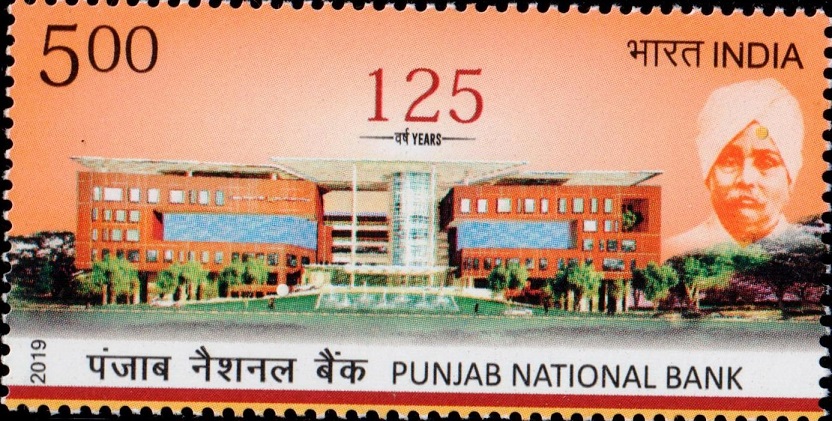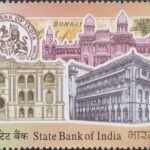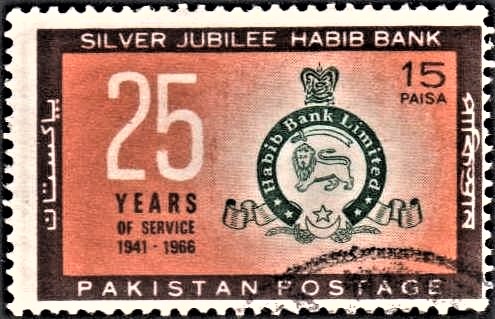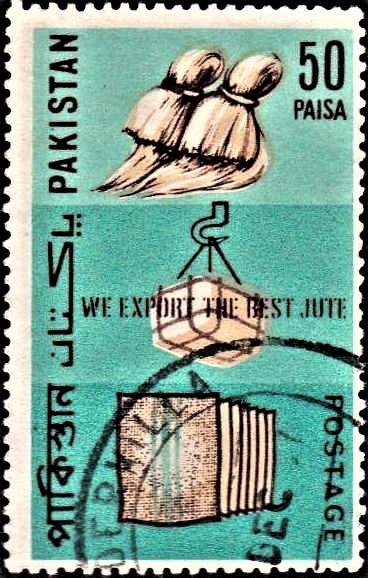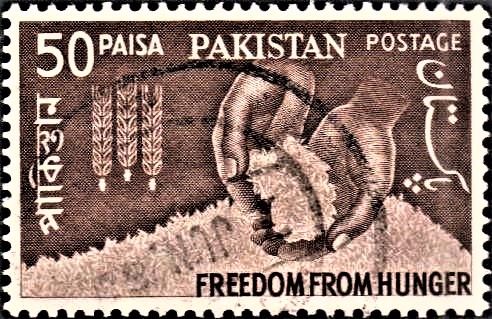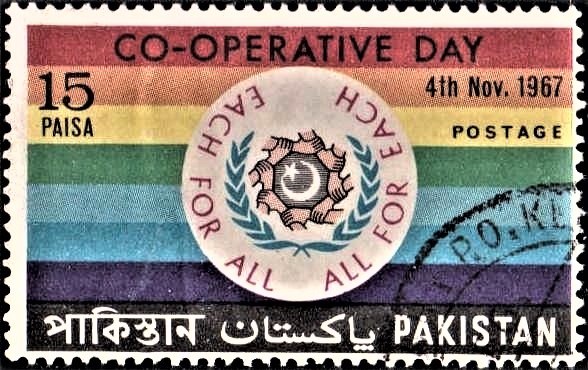
Pakistan on Co-operative Day 1967
A commemorative postage stamp on the Cooperative Day :
 Issued by Pakistan
Issued by Pakistan
Issued on Nov 4, 1967
Issued for : Pakistan Post Office is issuing a Commemorative Postage Stamp of 15 Paisa denomination on November 4, 1967, to observe the International Co-operative Day and to highlight the co-operative movement in Pakistan.
Design : The circular central portion of the stamp depicts the “Co-operative Day” emblem showing the slogan “Each for all – all for each” in Red around the wreath of U.N. emblem printed in Blue. The crescent and star of emblem appear in White against a Grey ground and are encircled by a formation of hands representing co-operation among all nations.
A spectrum of colours is printed as background representing all nations of the world in an abstract form. The colour bands are printed in their natural order viz., Red, Orange, Yellow, Green, Blue, Indigo and Violet.
The caption “Co-operative Day” is printed in black on the top band of colour. Denomination “15 Paisa” appears at the top left, the date of issue “4th November, 1967” and the word “Postage” appears at top right hand of the stamp. In the bottom panel the word “Pakistan” in English, Urdu and Bengali is printed in reverse against black ground.
Type : Stamp, Postal Used
Denomination : 15 Paisa
Colour : Red, Orange, Yellow, Green, Blue, Indigo, Violet and Black
Size of Stamp : 49.2 x 30.7 mm.
Size of Print : 46.2 x 27.7 mm.
Perforation Gauge : 13 x 13 (c)
Quantity Printed : 15,00,000
Number of stamps in each sheet : 50
Process of Printing : Litho Offset
Printers : The Pakistan Security Printing Corporation Ltd., Karachi
About :
- The Co-operative Movement emerged with the dawn of the 20th Century, fundamentally as an easy-credit-providing agency for the tiller of the soil, who, hithertofore, used to be born in debt, live in debt and die in debt, and aimed at creating credit-worthiness in him. In Pakistan, however, it has since developed into a live body intrinsically capable of bettering the economic lot of the common man. The movement stands channellised into multifarious spheres of activity and has become a lighthouse for a new way of life for the masses.
- The Co-operative Movement in this country started as an activity of the poor and its main object was to bring relief to those who were individually too weak and too isolated to stand on their own feet. In the beginning, emphasis was laid only on affording agricultural credit. After Independence, some more thought was given to it. In 1957, the State Bank of Pakistan revitalised the co-operative agricultural credit by giving financial assistance for the first time. It was, however, from 1958 that sincere attempts were made to tackle the problem in a comprehensive manner. Important committees were set up to study the various problems involved. Then came the important policy declaration of the Government in February 1962, which is as follows :–“The present Government is convinced that the Co-operative Movement which represents a system of economic democracy has great potential as an instrument of national advancement and has, therefore, decided to give its full support and assistance to the organization and development of co-operative societies in all fields of economic activity.”
- The foundation of the Movement has now been well laid and the activities have been diversified with necessary Government help and these now cover important sectors of rural economy concerning the common man.
- When the partition of the Indo-Pak Sub-Continent and the division of the Punjab Province paralysed banking and trade and disrupted the commercial life of West Pakistan, creating many economic problems of nation-wide magnitude, the co-operative movement stepped forward to cover the hitherto unknown ground and spread itself into new fields of operation to fill the vacuum. The central co-operative banks took up the financing of trade and industry and even of directly running industrial undertakings such as rice husking mills, flour mills and cotton ginning factories. Co-operative consumer stores, mill societies, multi-purpose societies, farming societies, tube-well societies, and transport societies, etc., were organized in large numbers.
- In West Pakistan, at present, there is a network of 29,071 co-operative societies. They have membership of 16,98,330 and a paid-up share capital of Rs. 11,98,51,000. The working capital is Rs. 1,18,83,93,000. These figures compare favourably with those of 1947 and show that the Co-operative Movement has made real and tangible progress.
- The West Pakistan Co–operative Union is a federal Co-operative Organization of West Pakistan. All co-operative institutions in West Pakistan are members of this Union and all co-operatives in the province are thus affiliated with it. The purpose of this Union is to promote the growth of co-operation and of co-operative business. It renders services to its member organizations and the common man in many ways: adopts publicity, propaganda and education measures; collects statistics; issues news about co-operative activities; helps train departmental staff and office bearers; holds conferences; supplies account registers and bylaws; furnishes books and literature and publishes journals on co-operation. The Union is consulted by the Government and other agencies in all matters relating to the development of the co-operative movement. It is a member of the I.C.A. and presents Movement’s point of view at national and international level.
- In East Pakistan, at the time of Independence, the Co-operative Movement consisted of 32,000 societies in a moribund condition, of which 27,000 were primary village agricultural credit societies with unlimited liability. To meet the situation an apex bank namely – the East Pakistan Provincial Co–operative Bank Ltd., was established in the year 1948. The moribund co-operatives became active, and their membership, share capital and reserves increased. The co-operatives in East Pakistan have, thus, become an effective agency for dispensation of agricultural credit.
- To further strengthen the co-operative credit structure, a scheme for development of co-operative credit and marketing structure costing Rs. 439.59 lacs was executed during the 2nd Five-Year plan and this is being continued under the 3rd Plan also in an expanded form. Under this scheme, 675 union multipurpose societies, 54 central co-operative banks, 35 central co-operative multipurpose societies, the East Pakistan Provincial Co-operative Bank and the Apex Marketing Society are being developed. Besides 16 co-operative land mortgage banks in 16 districts of East Pakistan (other than Chittagong Hill Tracts), 80 sugarcane growers’ societies, 450 fishermen’s co-operatives, 200 milk producers’ co-operatives in certain areas of Pabna District having abundant milk supply, 47 farming societies, 227 urban co-operative banks and societies etc., are functioning in that province.
- The progress undertaken by the co-operatives in all the sectors is stupendous. Implementation of the programmes of education, training, extension and improvement of general supervision simultaneously with the programme of development will certainly go a long way in raising the work standard and efficiency of all types of co-operatives, by supplying them their requirement of trained manpower including managerial skill as well as enlightened and loyal members, who should be fully aware of their rights and responsibilities.
- With the compliments of the Director General, Pakistan Post Office, Karachi.


